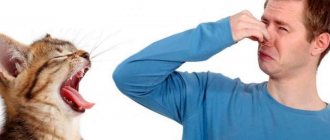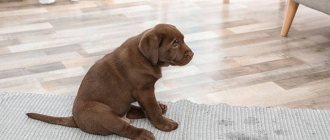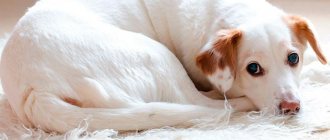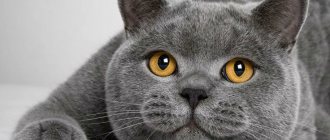Features of cats' paws
A special feature of cats is their paws, soft as pads, and claws as sharp as blades.
In nature, cats are successful hunters.
In other animals, claws are additional weapons to other parts of the body, but in cats they are the primary weapon for all occasions.
The cat catches its prey with its paw, and with its paw with outstretched claws it warns: don’t touch it! Cats use their paws to fight off obsessive pet lovers and use their paws to put rivals and enemies to flight. Thanks to their claws, we see cats decorating trees and fences; thanks to them, cats can leave and come home through the windows without causing us the inconvenience of closing and opening doors, and also open the door to the toilet and even the refrigerator themselves. All this is touching.
But there is one BUT. The environment and irrepressible children and guests suffer from these claws. Cats belong to the category of predatory animals, not plush toys, and, accordingly, as they should be by nature, they have their own character and needs.
Why does a cat sharpen its claws?
Cats do not sharpen their claws on expensive furniture and wallpaper. And they do not tear it out of anger, harm or a desire to annoy the owner.
To regenerate claws, which are so necessary for cats, they simply need to remove dead particles, giving the opportunity to grow new ones.
The most convenient equipment for this is furniture upholstery.
The cat doesn’t care how much it costs or how much the owner’s tights cost, which are so convenient to climb onto her lap. It’s good to stretch your muscles after sleep by clinging to silk wallpaper
And in the house there is a miracle face, colleagues, relatives, children and neighbors - everyone is in emotion. And the difficulties of coexistence begin. First comes castration and sterilization. It seems like that’s it, there’s a sofa cushion in the house. But no. A pillow with legs and teeth.
When children paint the wallpaper with their own hands and try to turn the knobs of the gas stove, what should they do? Of course, cut off your hands. Why stand on ceremony with a cat? They cut off the claws and fingers, and that was the end of it. So, the decision has been made.
On a note
Do we still remember the Nazis? They were experienced sadists and also liked to pull out nails. You can find out the feelings of the victims from their diaries and try them on your pet.
Article 10 of the European Convention adopted a law that prohibits declawing cats in 15 European countries. In the rest of Europe and America, the adoption of this law is under consideration.
There is no ban in our country, but veterinarians often refuse to perform declawing surgery for ethical reasons. To perform such an operation means to deliberately make the animal disabled.
Private veterinarians, whose main goal of work is making money, promise a heavenly life with the cutest creature in a home untouched by claws. Basically, this operation is performed by a doctor in the house where the cat lives, away from sight, and the cost increases.
If the owners really do not see other options, such as scratching posts, silicone pads, spray and deliberately decide on onychectomy, their task is to find a truly professional doctor and provide proper post-operative care. Only if the “soft paws” operation is successful will the cat remain the same favorite, just as cheerful, active and nosy.
Claw diseases in cats
Animals, like people, are susceptible to various types of diseases. Therefore, it is recommended to regularly check with a veterinarian and have your pets vaccinated on time. There are a whole range of diseases that cause cats’ claws to be in poor condition and worsen their mood.
Fungal diseases can cause a weakened cat's immune system, causing scabs and dark spots to appear. When an animal develops a disease, its body weakens and, as a result, its claws become separated. If you notice suspicious symptoms in your pet, it is advisable to immediately go to the veterinary clinic. The veterinarian will prescribe supervision. And soon your Muska or Barsik will again delight you with fun games.
In order to avoid health problems in animals, owners must inevitably be more attentive, and if a problem arises, immediately take the necessary measures to solve them. The facial appearance and well-being of the cat will depend on this.
Causes of nails growing into pads
Many pet owners make the dangerous mistake of trying to remove ingrown cat claws with their hands or even scissors. This should not be done under any circumstances - for such procedures it is recommended to purchase special wire cutters in advance. Carry out the manipulations in this order:
- Disinfect the instrument (use cologne, alcohol, vodka).
- Treat the affected area with an antiseptic.
- Trim only the keratinized part of the nail plate (do not touch the pad under any circumstances - blood vessels pass through here, which can easily be harmed).
- Using tweezers pre-treated with alcohol, pull out the nail; it is better to do this with a sharp movement.
- Carry out disinfection, use furatsilin solution.
- Apply an antibacterial drug to the wound.
Over the course of several days, carefully examine the cat - if inflammation or swelling appears, immediately go to a specialist.
There are several factors that cause an animal’s nail to begin to curve and become embedded in the soft tissue of the paw. First of all, this is insufficient and illiterate care of the owner. Trimming too infrequently or shortening it to a short length leads to rapid regrowth of the cat’s nail.
The growth defect and change in the shape of the formidable cat weapon are also influenced by genetic predisposition. Breeders note that if a cat was prone to this disease, then the offspring often have problems with the nail growing into the paw.
Various injuries and mechanical damage to the limb can lead to trouble, causing a change in the shape of the nail and an increase in its length.
Causes of the defect
Why do claws grow into paw pads? The main provoking factor is their uncontrolled growth and great length. A domestic cat does not always have the opportunity to wear them off on a hard surface. The owner, as a rule, prohibits scratching furniture legs. This promotes excessive nail growth. A claw that is too long can grow into the pad. There are a number of other reasons that can cause problems with cat claws:
- lack of vitamins and minerals in old age causes disruption of their growth, curvature, bending;
- injuries from falling from a great height, damage during play can deform it, which will cause a change in the shape of the nail and subsequently a growth defect;
- irregular pet care;
- genetic predisposition to claw deformation.
Help at the veterinary clinic
The extent of surgical intervention is determined by the doctor after a thorough examination of the animal. He evaluates the depth of the ingrowth, the degree of inflammation, and the general condition of the cat. If there are no complications, the doctor removes the problematic nail with a special tool, having previously treated the pad with an antiseptic. If inflammatory processes have already begun to develop, the operation is performed under local anesthetic. During the procedure, the veterinarian opens the abscess to remove the claw, pus, and clean out the wound. But very advanced cases require general anesthesia.
After the manipulations, the doctor applies a sterile bandage with antibacterial ointment to the furry patient. To neutralize the inflammatory process, he prescribes a course of antibiotics, and for a speedy recovery, he prescribes mineral and vitamin complex preparations. If the animal is too weakened, it adds drugs that strengthen the immune system to the treatment regimen.
During the rehabilitation of the furry, it is necessary to regularly change the bandages. At the same time, you should not glue them with adhesive tape, so as not to further injure the surrounding tissues. If the cause of an ingrown toenail is genetic, the problem is likely to recur. During a relapse, it is best not to treat the animal yourself, but to contact a veterinarian for a second course of treatment.
After the manipulations, the doctor applies a sterile bandage to the cat.
What should the owner do?
Sooner or later, the owner will notice that the pet is limping or frequently licking its paw. He will examine it and find a claw or several embedded in the pad. There will be redness and swelling around the injured soft tissue.
The owner will want to feel that place, but the pet will experience pain, fear and will struggle, hiss, and try to bite. Even if the owner has pliers that can be used to cut off the ingrown tip of the claw, he cannot cope alone. It happens that someone in the household holds the cat and the owner manages it himself. If he cannot do this, then the pet needs to be placed in a carrier and taken to an appointment with a veterinarian. He will definitely help.
How can an owner help a pet?
When the owner notices that the claw has grown into the pad, he will be able to help on his own only when the soft tissues around are not inflamed. An ingrown claw is cut off with pliers designed for trimming animal claws. Guillotine cutters won't help here.
The tool must be disinfected with alcohol or held over a fire. Wait until it cools down and carefully trim the claw, being careful not to touch its capillary and soft tissue of the pad. The ingrown piece of the claw is grabbed with tweezers or the same nippers and pulled in the opposite direction from the direction of ingrowth.
Now the paw pad is treated with an antiseptic, for example, peroxide, Chlorhexidine or Furacilin, or something else. The same claw needs to be trimmed as short as possible
It is important not to touch the vessel
What to do if your cat has ingrown claws:
If the area around the ingrown claw is red and swollen, you should not cut off or pull out the claw yourself. You need to take your pet to an appointment with a veterinarian and he will do it professionally. It will remove all pus from the wound and thoroughly disinfect it to avoid suppuration of the pad.
Signs that indicate a claw problem
If a cat's claw has grown into the pad, the owners who closely monitor the condition of their pet will be able to identify the problem without any problems. The following signs indicate an unpleasant manifestation:
- swelling appears on a finger with a deformed nail plate;
- the animal is severely lame on the hind leg or front leg (an ingrown claw leads to painful symptoms when walking);
- the pet refuses walks and games for fear of causing pain in the affected area;
- The cat regularly licks its paw, which causes discomfort, and tries to chew its claw.
Upon careful examination, which should be carried out immediately, it is easy to see that the nail plate is immersed in the pad. When pressed, the pet will show anxiety and try to escape, even bite. This is evidence that the animal is in severe pain.
Panaritium (inflammation of the claw bed)
Panaritium (inflammation of the nail bed) in cats, as a rule, develops due to injury or infection of the nail bed. Cats get injuries to their nails while climbing trees, when grinding their claws, or while playing. Infection of the nail bed is caused by pathogenic bacteria that penetrate through microcracks, wounds on the pads, and cuts. Acute inflammation develops, causing severe pain.
Breaking off, ingrown claws, metabolic disorders, neoplasms, and birth defects can also cause panaritium in cats.
Symptoms of felon in cats
The disease occurs acutely, subacutely, chronically. In the initial stages, it is not always possible to notice the development of the pathological process.
Symptoms of felon in a cat:
- restless behavior;
- decreased activity;
- temperature increase;
- hot swelling, soreness in the area of the claw bed;
- an unpleasant odor emanating from a source of suppuration, an inflamed paw.
At the beginning of the development of the pathological process, the cat attracts the owner’s attention with a plaintive meow, licks a sore paw, and limps, especially after sleep or short activity. The nail becomes soft, deformed, breaks off and even falls out
Treatment
At the initial stage of development, felon can be cured at home. The damaged nail bed is lubricated with antiseptic solutions, anti-inflammatory ointments, liniments, and iodine. They use decoctions, tinctures of medicinal herbs, bitter salt baths (Epsom salt, bitter English salt, sea salt).
A saline solution with the addition of iodine helps well with felon. Dilute a teaspoon of salt in three liters of hot water and add 5-6 drops of iodine solution. You can also use essential oils of eucalyptus, tea tree, and citrus fruits, which have an antiseptic effect.
In the treatment of panaritium, antimicrobial ointments (Vishnevsky's liniment, Konkov's ointment), antibiotic-based ointments (tetracycline), boric acid for dusting inflamed areas, and chlorhexidine solution are used.
Several times a day, the nail bed is cleaned of pus with a soft brush, using an antiseptic and laundry soap. During treatment, the general condition of the pet is monitored. If a cat is walking outside, the animal is not allowed out of the house until the symptoms are completely relieved.
If the inflammatory process is started, suppuration is noticeable, the cat’s condition has deteriorated sharply, the treatment did not produce results in the first two days, contact a veterinarian. After examination and diagnosis, the veterinarian will select adequate and effective treatment. The cat will be prescribed complete therapy, antibiotics, medications or surgery in particularly severe cases, for example, if the inflammation affects several fingers at the same time.
Causes
The appearance of growths on the paw pads occurs for various reasons, the main of which veterinarians consider:
- Traumatic damage to the claw - if for some reason a cat’s claw breaks at the very base or is completely torn off, skin tissue may begin to grow, which will accompany the process of forming a new claw. Typically, such formation does not cause discomfort and does not require treatment. It itself may go away in a year, or remain for life;
- The effect of chemicals on a cat's paw pads - skin growths appear due to the fact that in places where damage has occurred, keratinization of the skin occurs faster. The fabric seems to create a second layer. It does not have time to wear off, and the formation of a horn begins, which, due to its location on the paw pad, can interfere with the normal movement of the animal. The pads should be rid of it. In such a situation, the growth is removed in a veterinary clinic;
- Viral lesions of the body - a virus can often cause problems with the paws. Most often, growths on the pads appear if the body has viral leukemia or papillomavirus, which causes warts on the paws of a cat. The presence of the virus in the animal’s body is determined by a veterinarian after conducting the necessary tests. Papilloma and growths caused by viruses disappear after the pathogens are eliminated; why treatment prescribed by a veterinarian is necessary;
- Malignant neoplasms - occasionally, in old animals, a claw growth appears on the pad, the second name of which is cutaneous horn. This indicates that there is a developing squamous cell carcinoma or basal cell carcinoma. In such a situation, urgent veterinary treatment is required, in which therapy is carried out against developing oncology. This false claw, the cutaneous horn, is removed last. Treatment may last a year or more;
- Cyst – not observed often. A veterinarian can identify such growths without difficulty and with a minimum of tests. Outwardly, a cyst can resemble a normal growth of keratinized skin.
The first to notice the pathological formation on the skin of the pads and growths in the pet is the owner, who can, even before visiting a specialist, find information on this topic on the Internet and look at the photo. Often this helps to understand the seriousness of the situation in time and provide timely help to the cat. The topic of growths on the paw pads of cats is a common one and you can always consult your veterinarian regarding this.
How to help an animal?
First you need to determine the extent of the damage. A dog's ingrown claw that is not very deeply embedded in the pad can be removed independently. You need to pour chlorhexidine onto the wound and wipe your hands, why use pliers to bite off the tip of the stuck nail, leaving enough outside to then pull it out. Here lies one difficulty: to trim so as not to touch the pulp. Inside the claw there is living tissue with blood vessels. If it is damaged, a small amount of bleeding will begin. Therefore, you need to try to bite off only the empty part of the nail with pliers, but if blood still appears on the cut, then first you need to sprinkle a little chlorhexidine and treat it with a diluted iodine solution.
A deeply stuck overgrown claw should be removed by a veterinarian. Firstly, it probably won’t be possible to cut it without touching the pulp in it. Secondly, the part that gets into the pad cannot be removed on your own. After all, a dog’s nail is curved and as it grows in, it touches more and more living tissue. There is no reason to cause your pet more pain if a professional at the clinic can handle it quickly and with minimal inconvenience.
After the ingrown toenail has been removed, the wound will have to be treated at home for some time so that it heals without consequences. After a successful procedure, disinfection and healing ointments will be sufficient. To prevent your dog from licking the damaged area, a loose bandage may be needed. The distance from the bandage to the skin should allow it to “breathe” and dry out wet areas. There is no need to limit the animal’s activity; it still needs to walk and play. It is enough just to keep the healing area clean so that no dirt gets there and nothing scratches the skin again.
The problem of a dog having an ingrown nail can be easily solved if you react quickly. Your pet's paws should definitely be examined regularly, especially if he actively licks a specific place. Even at home, you can cut off an ingrown claw if it is not yet deeply embedded in the pad. Then it will be enough to remove it from the wound and treat it with chlorhexidine and, for example, Levomekol ointment. A severely damaged paw with a claw that has grown to the point of being rounded should be treated by a veterinarian.
Help at home
If the nail has not grown deep enough and an inflammatory process has not developed around it, then you can help the cat without the help of a veterinarian. It is important to know that this needs to be done correctly so as not to aggravate the situation. Under no circumstances should you bend the claw trying to pull it out.
- Before freeing the paw pad, you must first treat it with an antiseptic and disinfect the tool - the nail clipper;
- When declawing cats, you need to act carefully, trying not to touch the upper part where the blood vessels are located;
- After the claw is trimmed, you need to pull it out of the pad with tweezers in one sharp movement opposite to the direction of growth;
- After removing the claw, to prevent inflammation from occurring, the damaged area must again be treated with a disinfectant and antibacterial ointment. The trimmed claw should be shortened as much as possible.
Problems with cat claws
In fact, cats are quite easy to care for, but this does not mean that no problems will ever arise with them. There can be many unpleasant situations, and today we will describe some of them.
Ingrown claw
An ingrown nail in a person is far from uncommon, but not many people know that a cat’s claw can grow into the pad. This defect occurs due to the large, long nail plate and its curved shape.
The fact is that the claws grow from the top of the pad and bend downward. But at their normal length, contact with the pad does not occur, and if the plate grows too long, then it pierces the soft base of the paw and grows into it.
An ingrown claw is very unpleasant and quite painful.
This often happens when the cat is at an “advanced” age and has never had its claws trimmed or has had it done very rarely. In old age, the shape and structure of the claws begin to change, and irregular care in addition to this leads to its ingrowth.
What can be done in this case?
- If there is no serious wound, then you need to carefully cut off the end of the claw, without touching the body with blood vessels, remove the cut part from the pad, and treat the paw itself with hydrogen peroxide.
- If there is serious damage to the soft part of the paw, you should take the animal to a veterinary clinic. In this case, it may be necessary to completely remove the claw plate, after which the specialist will treat the wound with an antiseptic and prescribe antibiotics.
Claw delamination
If a cat's claws are peeling, then, first of all, it is necessary to establish the cause of what is happening. They may be as follows:
- the claws grow and at the same time their stratum corneum is renewed - in this case, a scaly capsule begins to envelop the claw, which after a while comes off and delamination occurs. This can be easily eliminated at home using a scratching post;
- insufficient care after cutting - a carelessly performed procedure can cause injury to the claw plate;
- lack of vitamins – a cat’s diet must be balanced, and a lack of nutrients often provokes dehiscence of claws.
The first reason is natural, so it is the next two that require the owners’ attention.
Delamination of the claw plate can be prevented with the help of anti-scratches. They are made of soft silicone and are absolutely safe for animals.
Be attentive to your pets and try to give them as much free time as possible. And if a problem with claws is detected in the first stages of development, it will be quite easy to eliminate it.
To cut or not to cut?
The answer to the question whether cats can have their claws trimmed will be unequivocal - yes. But is it necessary to do this... Before starting the procedure, you should remember that claws are an integral part of the cat’s body. They are given to animals by nature and not at all in order to spoil a person’s life, but for natural needs.
And when taking such an animal into your home, a person must understand that he assumes responsibility for the health of the pet.
If a cat sharpens its claws on furniture or wallpaper, then a claw sharpener or scratching post will help solve this problem. And if you install it in the right place and make sure that the animal gets used to it, then you can do without trimming its claws.
We suggest you read: British Longhair cat how to care for it
It’s another matter when a small child appears in the house, who, due to his age, is not able to fully control his relationship with a furry pet. In this situation, the procedure for trimming claws will be completely justified.
Pododermatitis
Pododermatitis or inflammation of the soft tissues of the paws is the most common disease in cats and dogs. During pododermatitis, the animal has difficulty taking normal steps, and any movement leads to severe discomfort and pain. Because of this, cats and kittens develop nervousness and aggressive behavior.
shutterstock
It is difficult to identify this diagnosis in the first stages; they are impossible for the average person to notice. Therefore, the disease starts, and the consequences become irreversible.
Causes of the disease:
- influence of pathogenic bacteria. When a cat has injured its paw, the variation in bacteria entering the body increases significantly. Incorrect disinfecting manipulations cause fungal manifestations in the tissues of the paws. It is difficult to detect and even more difficult to treat. Most often, the result is a chronic fungal disease.
- hypothermia. During the cold period, there is a risk of severe hypothermia, and therefore it is not recommended to let cats go for a walk during this period. The streets are filled with chemicals, and they can irritate the delicate tissue of the paws, which can cause necrosis in felines. Because of this, the pads are completely destroyed, and as a result - lameness.
- exposure to allergens. Allergens can cause dermatitis; indoor cats are more susceptible to this. A weakened animal's immune system may not cope well with this disease.
- consequences of autoimmune diseases. Most often, plasmacytic pododermatitis appears after autoimmune diseases. Due to the late detection and treatment of the disease, it is necessary to give the cat special medications throughout its life to keep the disease under control.
Symptoms and diagnosis of pododermatitis
Every second observation will help to identify any disease in the early stages, and contacting a specialist in the early stages will help to avoid negative consequences and quickly cure feline diseases in a cat.
In the initial stages of paw pad problems, there are various symptoms:
- the cat spends a lot of time on paw hygiene
- the pads are very soft
- From time to time blood is visible on the surface of the pads
Ignoring any of the signs can contribute to the development of severe necrosis, which carries with it a high likelihood of sepsis. In this case, veterinarians cannot guarantee a high survival rate for the cat, and most methods of treating the disease are ineffective.
shutterstock
Useful video
To learn what to do if your cat has an ingrown nail, watch this video:
Subtleties and nuances of how to trim a cat's claws. Having settled a fluffy beauty in his home, the owner takes on a lot of problems. It is primarily necessary to carry out manipulation in order to prevent the nail from growing into the soft tissues of the paw.
How to treat an open wound in a cat depends on the further development of the traumatic process. Solutions such as chlorhexidine, furatsilin solution, and fucorcin will cope well with the task of disinfection.
How does phlegmon manifest in cats, how dangerous it is and how to treat it. The occurrence of various types of inflammatory processes in pets is not uncommon.
Diseases of paws and claws in cats - symptoms, causes and first aid
Diseases of paws and claws
Cats, like no one else, need healthy paws in order to climb trees and make successful landings on the ground.
That's why it's important to regularly examine your cat's paws for wounds and various diseases.
The first thing you should pay attention to is the cleanliness of the paws. No dirt, debris or chemicals should be present on them
In addition to causing pain and irritation, these substances can get onto the tongue and then into the digestive system, causing poisoning. Once a day, inspect your cat's paws for wounds, splinters, splinters and tumors, do not forget to check the areas between the toes and, if necessary, wipe them with a damp cloth.
Felines constantly need to scratch, so they keep their claws sharp and clean. Provide your kitten with several different types of scratching posts so she can sharpen her claws at any time.
When a claw grows into the soft pads of the paws, the consequence is inflammation and suppuration of the skin around the claw. As a rule, this disease affects animals that move very little.
If you know your cat is susceptible to this condition, trim its nails regularly. You need to prepare your pet for this procedure gradually. When the cat is in a calm and relaxed state, take the paw gently in your palm, lightly press on its top and the soft pad below - this will cause the claw to come out of the claw sac and become bare. Using sharp, high-quality nail scissors or a special tool - a nail clipper, cut off the white tip of the claw to the border of the blood supply without touching it (the place where it begins to bend). Do everything very well
Source
How to trim nails?
First of all, you need to understand that an inept approach to the nail trimming procedure can cause pain to the animal, and in some cases, health problems. Therefore, to begin with, we will look at the tools with which this can be done as correctly as possible, and then we will describe the procedure itself.
What can you use to cut your hair?
For safe and convenient trimming of cat's claws, several special devices have been invented and put on sale. They are called nail clippers and can be presented in two types: scissors and forceps.
Scissors
Special scissors for trimming cat claws can be purchased at a pet store or veterinary pharmacy. Outwardly, they are similar to ordinary scissors, but there is also a difference - the shape of the tool, thanks to which the claw is securely fixed and at the same time the risk of damage to it during cutting is reduced to zero. At the same time, the cutting surfaces of this device are somewhat reinforced, since the cat's claw is quite dense and hard.
These scissors are suitable for both adult cats and kittens
Nippers, or nippers, for trimming nails allow you to carry out the procedure itself very quickly. This device works on the principle of a guillotine - one confident sharp pressure and the tip of the claw is as if it were never there. The tongs cut it instantly, without cutting, breaking or sawing it.
As a result, the pet owner gets quick results, and the animal itself does not even have time to be “indignant” about everything that is happening. The cut is very neat, which makes these pliers a more “advanced” tool compared to scissors.
Cat nail clippers provide the best quality cut possible
How to cut your hair?
So, let's move on to the main thing - how to trim a cat's claws correctly. It is very good if your cat is half asleep during the procedure, in this case everything can be done quickly and efficiently. If you were unable to catch your pet half asleep, then wait until he has finished all his business, including games, and only then begin the procedure.
The procedure for cutting nails is carried out in the following sequence:
- Wash the hands;
- treat the nail clipper with alcohol or an alcohol-containing solution;
- take the cat in your arms and caress it - the animal should feel your goodwill;
- take your pet’s paw in your hand, this must be done confidently, but gently;
- press the center of the pad so that the claw opens;
- examine the claw in the light - this will allow you to see pink tissue, which in no case should be touched;
If the cat's claws are light, then the sensitive area will be clearly visible - trim the edge of the claw, leaving 2 mm to the pink tissue;
- repeat the procedure with the remaining claws.
We invite you to read: Characteristics of shorthaired pointer dogs
During the procedure, it is necessary to constantly talk to the animal and praise it, even if it does not behave entirely calmly. And at the end, don’t forget to treat your cat with her favorite treat.
The question of how often to trim a cat's claws will not have a clear answer. The frequency of this procedure may depend on a number of factors:
- the rate of growth of the claw plate, which depends on the characteristics of the animal’s body;
- the speed of claw growth depending on their color - light plates grow faster than dark ones;
- characteristics of the animal’s character and behavior - active cats will constantly sharpen their claws themselves;
While slow and lazy pets will simply lie on their favorite sofa, and, accordingly, their claws will sharpen much more slowly
Therefore, the owner must determine the frequency of the procedure independently, examining his pet’s claws from time to time.










